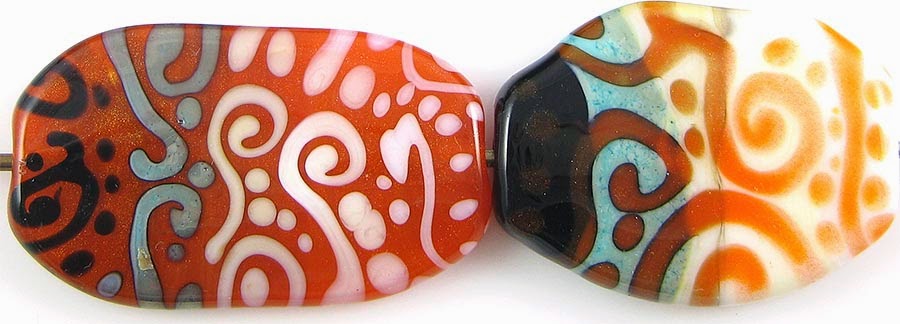1 - Plain (reduced), 2 - Plain, 3 - Over Clear, 4 - w/ Silver Leaf, 5 - w/ Silver Leaf (reduced & encased), 6 - w/ Silver Glass Frit (reduced), 7 - w/ TerraNova2 Frit, 8 - Over Silver Foil, 9 & 10 - w/ Tuxedo, Copper Green, Opal Yellow, Ivory, and Peace
Gold Violet is pretty with silver, and it is awesome to have a transparent pink that can be used with Ivory without turning the Ivory black. The other thing that is really cool about Gold Violet is that it seems not to mind being encased.
Here, you can see that when silver is used on top of Gold Violet, the colour of the Gold Violet browns up a little and the silver geads up on top of it. If you reduce and encase the silver, it turns blue and leaves a blueish haze across the base glass. The bead on the left is unimpressive and sort of icky looking, but it can be easily transformed into the bead on the right by reducing and encasing it with Clear.
Here, you can see that encasing silver foil with Gold Violet has resulted in the colour of the gold violet being lightened and reflected back at us with minimal discolouration. I was expecting it to turn orange the way it did when I encased silver with Cranberry, and was pleasantly surprised that it didn't really do that.
Reducing silver glass is gorgeous on top of Gold Violet. Not only did I get beautiful, vivid colour, but I also got some interesting mottling and edging to the fritty bits that I do not see with a lot of other colours. I got some colour out of my TerraNova2 frit as well, but because that colour strikes mostly pink and purple, it is sort of lost against the base.
And now this is the most magical part of my show and tell about Gold Violet.
Instead of separating and going turquoise with Gold Violet, Copper Green develops a dark patina. I'm not sure this is very attractive, but it is an interesting change. I probably wouldn't do this on purpose, but it is good information for you because you should absolutely not approach using this colour with Copper Green (or anything else) the way you would approach it with Rubino or Cranberry.
On top of Gold Violet, Opal Yellow and Peace both develop a subtle border that makes those colours look three-dimensional on top of Gold Violet. In my opinion, the reaction with Peace on top of Gold Violet is really attractive.
Ivory is the biggest surprise here. You can see that on top of Gold Violet, the Ivory has separated and curdled a little, but mostly stayed in place. It has not turned black or brown even a little bit. When I used Gold Violet on top of Ivory, nothing weird happened there either.
Finally, here is a goddess bead made with Gold Violet. You can sort of see pink in her if you look close where the light is shining through, but anything sculptural made from this colour is going to look almost black because the colour is so dense.























































